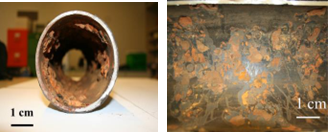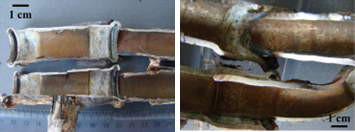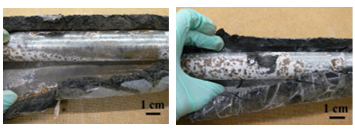Article / Case Study
University of Applied Sciences of Southern Switzerland, DACD, V. Flora Ruchat 15, 6850 Mendrisio, Switzerland,
C. Paglia
University of Applied Sciences of Southern Switzerland,
DACD, V. Flora Ruchat 15
6850 Mendrisio
Switzerland
6 July 2022 ; 21 July 2022
The water plants are widely used in building structures. They transport drinking water to the households, they refresh or warm up the rooms where we are living, they provide the water in case of fire along the sprinkler systems. Pipes are usually made of metals. These latter exhibit a critical behaviour in contact with water during an inappropriate service life or material choice. In water pipe plants, often corrosion takes place from the external surface and leads to the formation of craters and perforation. The presence of residual water within the embedding material is occasionally observed after the placing works. Condensation phenomena during the transportation of cold water within the pipe may emphasize the corrosion phenomena. The humidity is often adsorbed by the thermal insulating material of the pipe, enhancing corrosion. Galvanic coupling between different materials still represents a relevant issue. Furthermore, material chemical inhomogeneities, junctions and variable thin Zinc thickness of the coating layers contribute to the degradation. Internal corrosion features are also seen sporadically. In particular, in the presence of periodical Oxygen enrichments. On the other hand, stray- current and electrical earth systems generally do not represent a problem.
Keywords: plants, metals, water, durability, corrosion
The corrosion is an electrochemical interaction between a metal surface and its environment (Jones, 1996). Water or humidity, chemical agents, such as Oxygen or other cathodic compounds, acids, alkaline liquids or salts cause the degradation of metallic materials. Many metals used in the construction field exhibit corrosion related issues, especially low alloyed steels. The addition of Chrome to these latter increases and controls the corrosion resistance also in harsh environments (Yang Yu et al., 2018). The use of Molybdenum in percentage above 3% further decreases the corrosion susceptibility (Zimmermann, 2009). This is particularly critical in swimming pools (Nickel Development Institute [NIDI], 1995). Chloride anions also attack high strength aluminum alloys by promoting various types of localized corrosion and environmental cracking (Paglia & Buchheit, 2008).
Many building and civil engineering infrastructure suffer from the corrosion deterioration phenomena and several methods were developed in order to implement the diagnostic through electrochemical potential measurements (Elsener et al., 1996). Bridges, tunnels, desalinization plants are among the most exposed structures to salt aggressive environments. In this concern, the appropriate material choice may help to face the damage. Stainless steels (Stainless steel in construction, 2015) is a commonly used alternative to low alloyed steels to increase the resistance, but an inappropriate type or combination can lead to a reverse effect and accelerate the corrosion in different structures (Mosca et al., 2022). Titanium is used in heat exchanger desalinization plants due to its high resistance to chlorides. Drinking water reservoir may also be subjected to particular electrochemical conditions to form macro cells. The difference in the electrochemical potentials leads to an adverse current flow through the plant and the cementitious coating. This causes the dissolution of the cement binder with a local softening of the material (Paglia et al., 2004).
Nevertheless, not only the engineering structures subjected to severe chemical adverse conditions may suffer from corrosion. More common water plants may exhibit different forms of corrosion. Depending on the temperature, environment and service conditions, the attack may be intense. The goal of this paper is to outline the damage of water plants in order to prevent future unexpected deterioration and conceptual mistakes.
Experimental Procedure
The investigation of the plants or part of them was mainly done by visual inspection. In some cases binocular lenses were used. The service condition of each plant was described in the case it was essential to identify the reason for the deterioration. The chemical analysis were done with a portable X-ray fluorescence device with spot measurements. In order to better clarify the damage or failure, parts of the plants were sawn, cut and taken to the laboratory for the detail analysis.
Drinkable Water Distribution Plant
The plant belonged to a part of a water distribution net. The total length of the pipes was 800 meters. The years of construction ranged from 1960-70. The pipelines consisted of a low alloyed steel 1.0037 and were placed underground at a variable depth between 80 and 250 centimeters. The system was constantly filled with water. The service pressure was <8 bar. The samples were cut for evaluation along a distance of 60 meters.
The pipelines were coated with a bituminous-based system with an original thickness ranging from 2 to 3mm. At the time of the investigation, the coating thickness was reduced to 1-3mm (Fig. 1a). Local cracks were present and reached the steel surface causing the coating detachment (Fig. 1b). The crack pattern assumed a net-like shape (Fig. 1c). A slight surface uniform corrosion was observed, although locally also some craters were detected.

a b c
Figure 1: External coating degradation of the pipe.
The internal pipe coating thickness was 0.5 mm. In some areas, the coating detached or was absent. In these zones, corrosion initiation was observed (Fig. 2 a). Locally the degradation was intense. Nevertheless, the electrochemical attacks never led to perforation of the pipe wall (Fig. 2b).
 a b
a b
Figure 2: Internal coating damage of the water pipe.
During 40 years, a constant degradation occurred on both the external and internal coating system. In spite of the local intense damage, the corrosion was mainly seen as an uniform attack that proceeded at a slow speed with time and did not lead to perforation.
Water heating plant
A water heating pipeline plant was placed within a pavement. The upper surface level consisted of tiles with 1.2cm in thickness, fibre reinforced cement-based material and a rebar net for a total thickness of 10cm. Underneath a plastic foil, a styrofoam insulation with a thickness of 2cm and a 2cm thick mineral wool insulation were placed. The base of the pavement consisted of concrete (Fig. 3 a). Corrosion was seen along a Zinc-coated steel curvature. Sometimes the deterioration exhibited an initial stage (Fig. 3 b). In other regions, the corrosion indicated an advanced stage with localized corrosion, the formation of craters on the external surface, current exit, perforation and water leakage (Fig. 3 c).
 a b c
a b c
Figure 3: Pavement stratigraphy (a) and pipe external corrosion (b, c).
The internal surface exhibited a slight corrosion of the pipe and the junctions (Fig. 4a). The chemical analysis of the water indicated only a slightly aggressive environment, that was caused by the free-CO2 content (Fig. 4b).
 Figure 4: Internal pipe and junction corrosion.
Figure 4: Internal pipe and junction corrosion.
A chemical analysis of the Zinc-coated curvature showed a reduction of the Zinc content caused from corrosion. A variation of Silicon, Manganese, Chrome and Titanium was seen between the corroded and the uncorroded portions (Table 1). The chemical variation influenced the stability of the Zinc coating. In addition, the presence of inhomogeneities also influenced the corrosion. Furthermore, the bending process of the curvature may form microcracks and acts as initiation points for degradation. The lack of a synthetic coating may further reduce the corrosion resistance in such an environment.
| Corroded curvature | Sb | < LOD |
|---|---|---|
| Pd | < LOD | |
| Ru | < LOD | |
| Mo | < LOD | |
| Zn | 1.056 | |
| Fe | 97.489 | |
| Mn | 0.292 | |
| Cr | 0.091 | |
| V | 0.038 | |
| Ti | 0.018 | |
| Si | 0.615 | |
| uncorroded curvature | Sb | < LOD |
| Pd | < LOD | |
| Ru | < LOD | |
| Mo | < LOD | |
| Se | 0.042 | |
| Zn | 62.839 | |
| Co | 0.480 | |
| Fe | 35.709 | |
| Mn | < LOD | |
| Cr | 0.202 | |
| V | 0.107 | |
| Ti | < LOD | |
| Si | 0.365 |
Table 1: XRF chemical analysis of a Zinc coated curvature investigated with a portable device. The content is expressed in [%].
In this case, the corrosion took place mainly along the external part of the pipeline. This was due to the relative presence of humidity / water enrichments and the lack of an appropriate embedment or protection of the metallic parts. This occurred during the placing works or with time due the inappropriate quality of the materials and coatings.
Water cooling / heating plant
In a water cooling / heating plant a Zinc coated pipe for warm water was placed on the upper level of a pavement, while the cold water pipe system was present at the lower level. Both systems were relatively close one another (Fig. 5 a). The water cooling plant exhibited external corrosion with a crater formation and perforation (Fig. 5 b). The system exhibited a slight corrosion of the internal pipes only after one year of service (Fig. 5 c). The water chemical analysis showed a poorly aggressive water with no presence of CO2 aggressive (0.0 mg/L) and a relatively low chloride content (10.6 mg/L). The embedding cementitious material around the insulating pipe exhibited conventional chloride, sulphate, nitrates and calcium content. They could not be considered critical with respect to localized corrosion. The corrosion occurred in the cooling pipes and was caused by the lower surface temperature of the pipe (7-12 °C). The heating pipe plant did not show damage. The external corrosion with the formation of crater was due to the presence of humidity, local chemical impurities and an inappropriate Zinc coating. The thermal insulation layer avoided the direct contact of the pipes with the basicity of the cementitious material, thus reducing the protection. Furthermore, the insulation embedment acted as a sponge for the humidity and enhanced the corrosion processes.

a b c
Figure 5:Water cooling / heating systems and corrosion features.
A further cooling / heating plant consisted of a low alloyed carbon steel, type 1.0034 E 195, with a thin wall welded longitudinally. The Zinc coating thickness was 8-12 µm. The plant transported warm water in the Winter time and cold water in the Sommer. Within the room, steady-state humidity conditions dominated and no increases were detected. Intense uniform corrosion with local crater formation and perforation were seen (Fig. 6 a). A presence of humidity with water condensate were observed on the pipe external surface. A crater and a perforation of 1 mm diameter was seen from the external (Fig. 6 b) to the internal surface (Fig. 6 c). The internal pipe degradation was limited. Craters formed from the external surface. Internally, the presence of multiple pit-like degradation was detected (Fig. 6 c).

a b c
Figure 6: Advanced uniform corrosion with craters formation.
The corrosion of the Zinc coating, so called white rust, was promoted by the presence of humidity, and an initial corrosion of the underlying steel was seen (Fig. 7 a). In some areas the deterioration proceeded to an advanced level till perforation (Fig. 7 b).

a b
Figure 7: White rust on the Zing coating and initial steel corrosion.
The combination of cooling and heating system is often not simple. Water or humidity permanence within the pavement or condensation phenomena due to changes in the relative humidity or the functionality (heating / cooling), as well as the vicinity of the pipe systems and a poor material quality may all contribute to a relevant damage after a very short period of service.
Fan coils
The air conditioners are widely widespread in order to maintain a healthy and an appropriate clima within rooms. The thermal and humidity sollicitations of such plants are high. The analyzed fan coils exhibited uniform corrosion along the internal surface of the collecting condensation water tank after a relatively short period of time of 2 years (Fig. 8 a). Along the lower surface of the collecting tray, white rust corrosion was seen. Uniform corrosion at an initial stage was present along the Zinc coated profiles in the zone of Cu-pipes insertion in the heat exchanger. On the other hand, no corrosion was found on the aluminum lamellae (Fig. 8 b). The measured Zinc coating thickness mean was 12.7 ± 2.6 μm (out of 25 measurements). The tolerance range Z140 was 7-15 μm with a typical value of 10 μm or for Z200 with a range 10-20 μm with a typical value 14 μm [9].

a b c
Figure 8:Corrosion on a fan coil device.
The prolonged stagnant water, the too low Zinc coating thickness for such service conditions and the galvanic corrosion between the Copper tube and the Zinc coated elements (Fig. 8 c) promoted the degradation of the plant.
Sprinkler installation
The sprinkler systems are among the first plants activated in case of fire. In a large shopping center a sprinkler installation was made of low alloyed steel 1.0034. Periodically, enlargements of the surface and the addition of new shops took place. The pipe system was alternatively emptied and filled with water to allow the construction works. In this manner, a periodical Oxygen enrichment could enter the pipe system. After a relatively short period of time, internal pipe corrosion appeared. The corrosion proceeded to an advanced stage. Craters formed from the inside till perforation (Fig. 9). Moreover, the sprinkler nozzles were oriented downwards. They were filled with corrosion products resulting from the pipe. Consequently, clogging of the system in case of fire could be expected.

In water pipe plants, often corrosion takes place from the external surface with the formation of craters and perforation. This can happens due to the presence of residual water after the placing works as well as to condensation phenomena during the transportation of cold water within the pipes. Humidity is often adsorbed by the thermal insulation material of the pipe system and enhances the corrosion. Galvanic coupling between different materials still represents a critical issue, while the material chemical inhomogeneities, the junctions and a variable Zinc coating thickness may contribute to the degradation. Internal corrosion phenomena are also present sporadically. Especially in the presence of periodical Oxygen enrichments. On the contrary, the stray-current and the earth system generally do not represent an issue for the described types of water plants.
The authors would like to thank the technicians of the Institute of materials and construction, Supsi, for sample preparation.
- Jones, D. A. (1996). Principles and prevention of corrosion, (2nd edition). Retrieved from https://www.worldcat.org/title/principles-and-prevention-of-corrosion/oclc/951318407
- Yang Yu, S. Shironita, K. Souma, & M. Umeda. (2018). Effect of chromium content on the corrosion resistance of ferritic stainless steels in sulfuric acid solution. Heliyon, 4(11), e00958. https://doi.org/10.1016/j.heliyon.2018.e00958
- Zimmermann G. (2009). Damage in swimming pools, Fraunhofer IRB Verlag 43.
- Nickel Development Institute (NIDI). (1995). Stainless steel in swimming pool buildings. Retrieved from chrome-extension://efaidnbmnnnibpcajpcglclefindmkaj/https://nickelinstitute.org/media/1805/stainlesssteelinswimmingpoolbuidlings_12010_.pdf
- Paglia, C. & R. G. Buchheit. (2008). A Look in the corrosion of aluminum alloys friction stir welds, Viewpoint set no. 43, Friction stir processing, Scripta Materialia, 58(5), pp. 383- 387. https://doi.org/10.1016/j.scriptamat.2007.10.043
- B. Elsener, D. Flückiger, H. Wojtas, & H. Böhni. (1996). Methods to evaluate the corrosion of steel in concrete, Swiss federal office of roads, Research 85/88, Research group bridges.
- Stainless steel in construction. (2015). Technical report 6, ISER-Guideline (875), https://www.edelstahl-rostfrei.de/
- Mosca, C., C. Paglia, & A. Jornet. (2022). The degradation of the most common stainless steels: real case issues, The 11th International conference on advanced materials and engineering materials, ICAMEM, March 29-30.
- Paglia C., F. Wenk, & R.O. Müller. (2004). Corrosion of water service reservoirs and preventive measures, The 1st International conference on service reservoirs, Geneva, 95-102.
- European norm EN 10346. (2015). continuously hot dip coated steel strip and sheet products. Retrieved from https://standards.iteh.ai/catalog/standards/cen/72eb4d83-f5b5-4e2f-95be-76762aa21fa8/en-10346-2015













